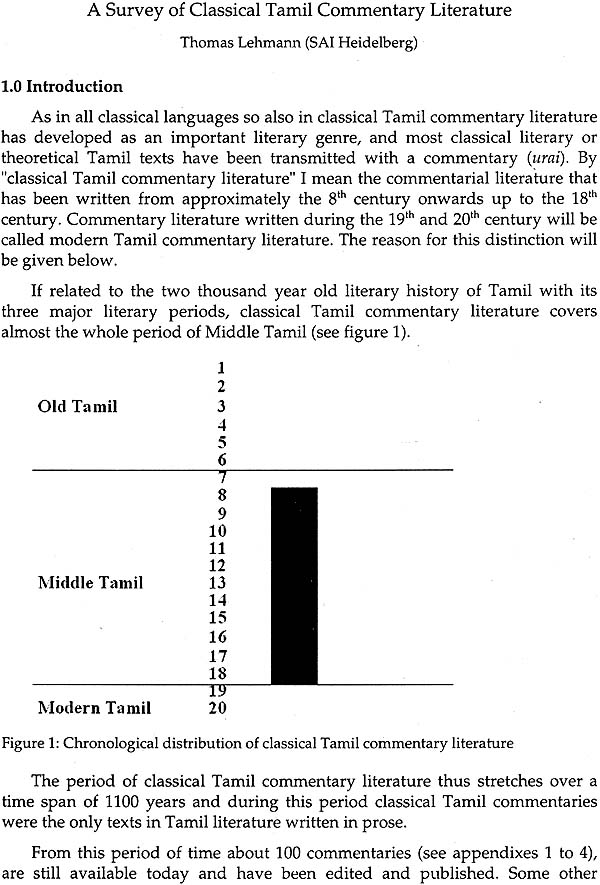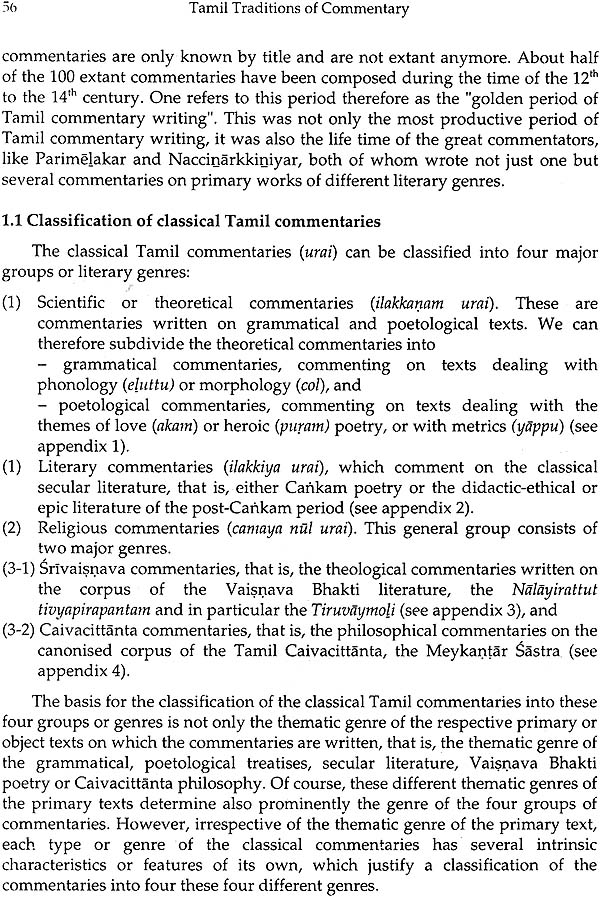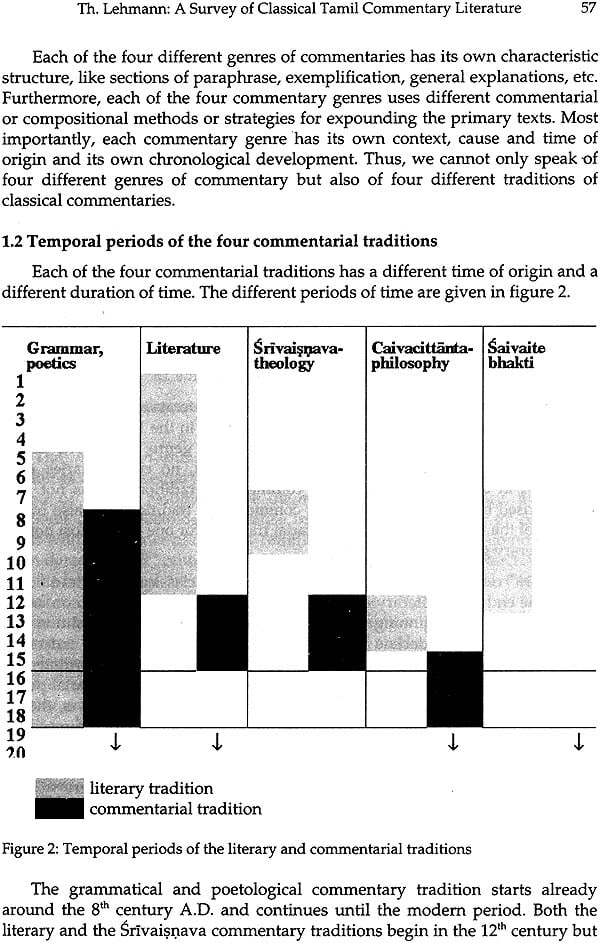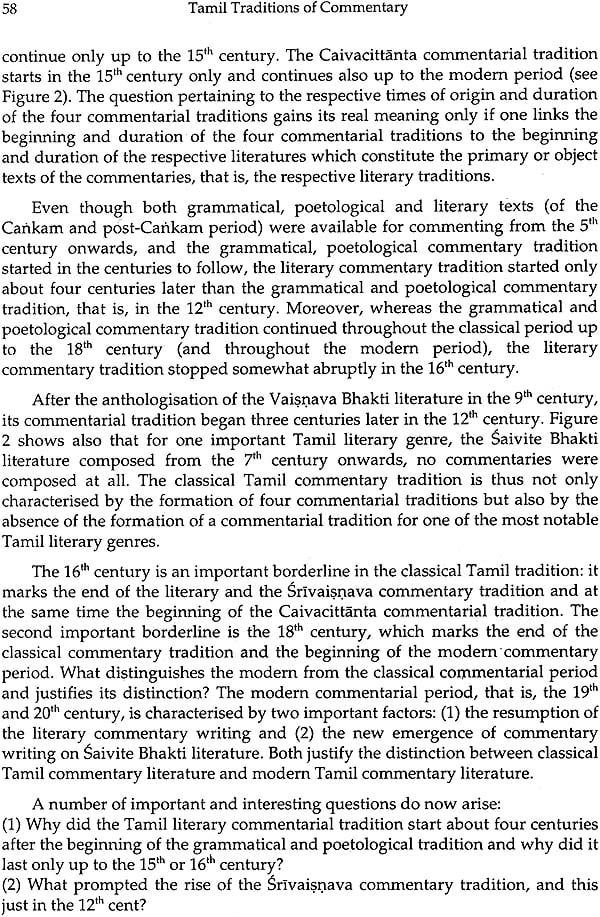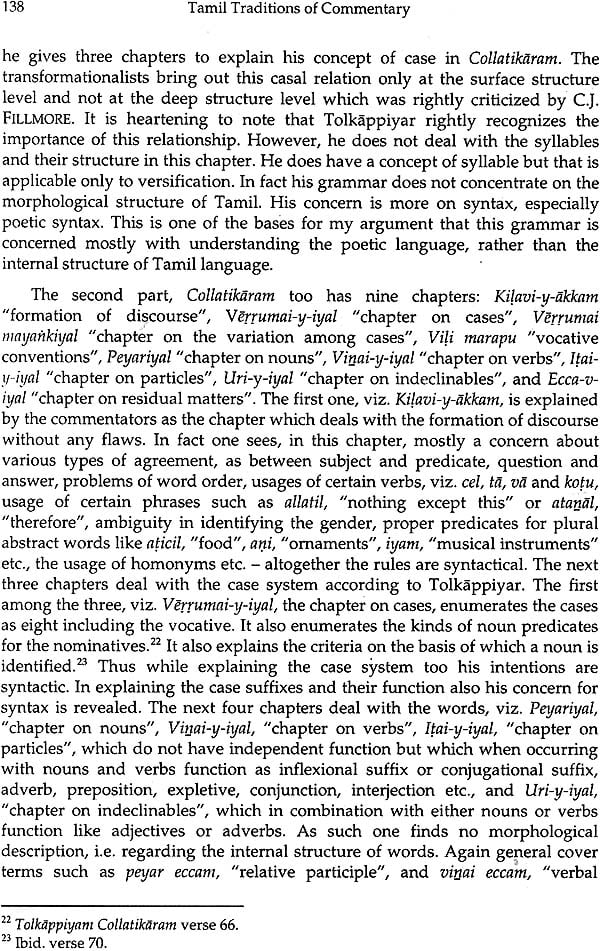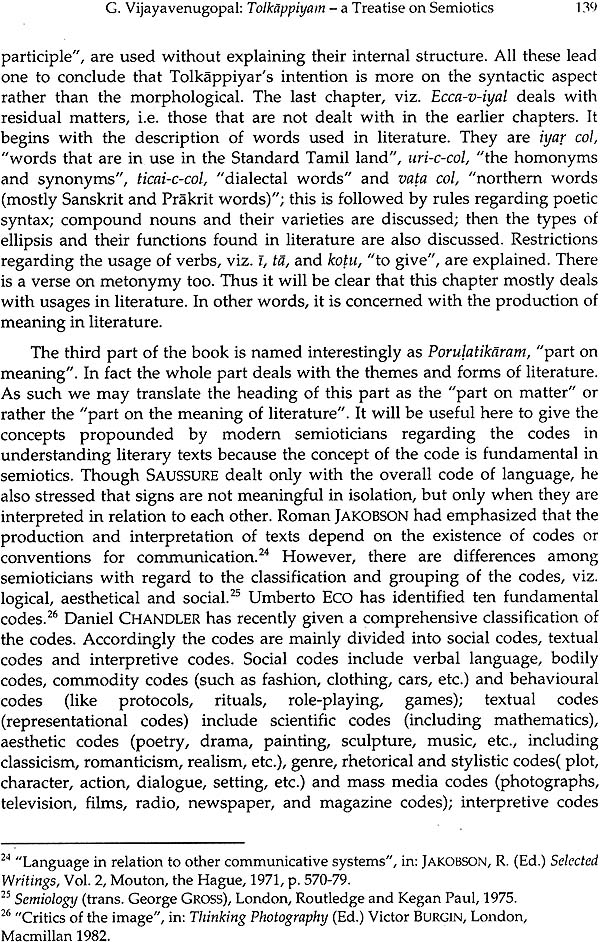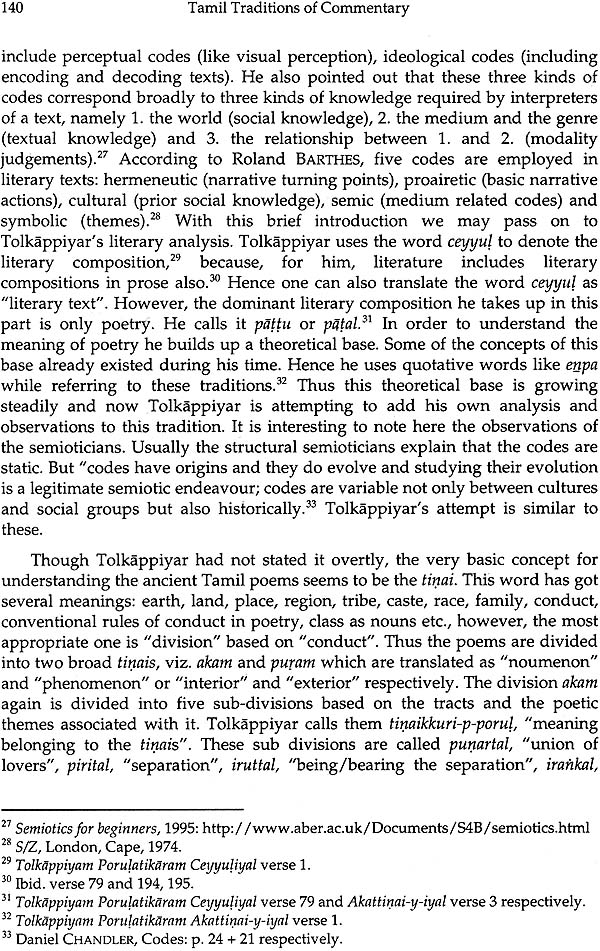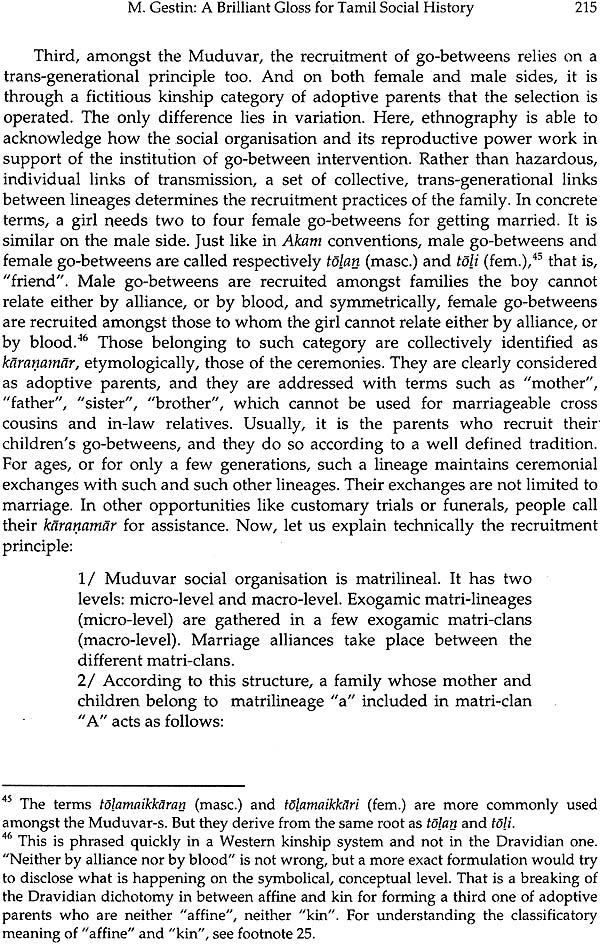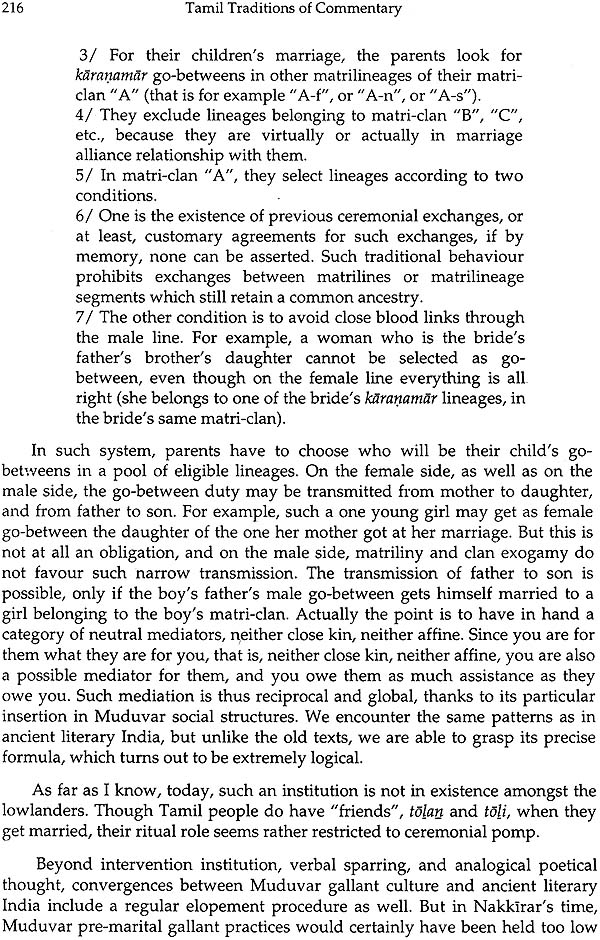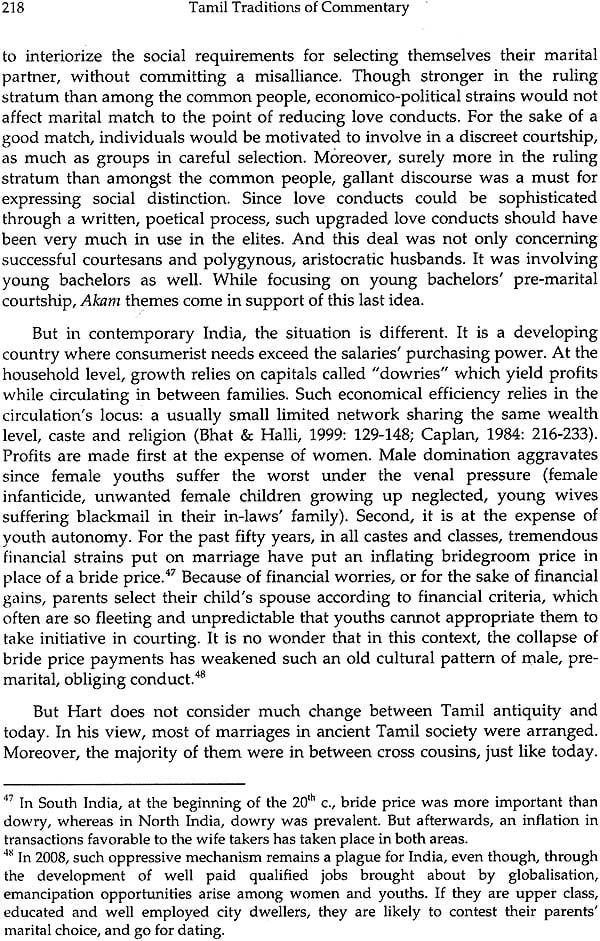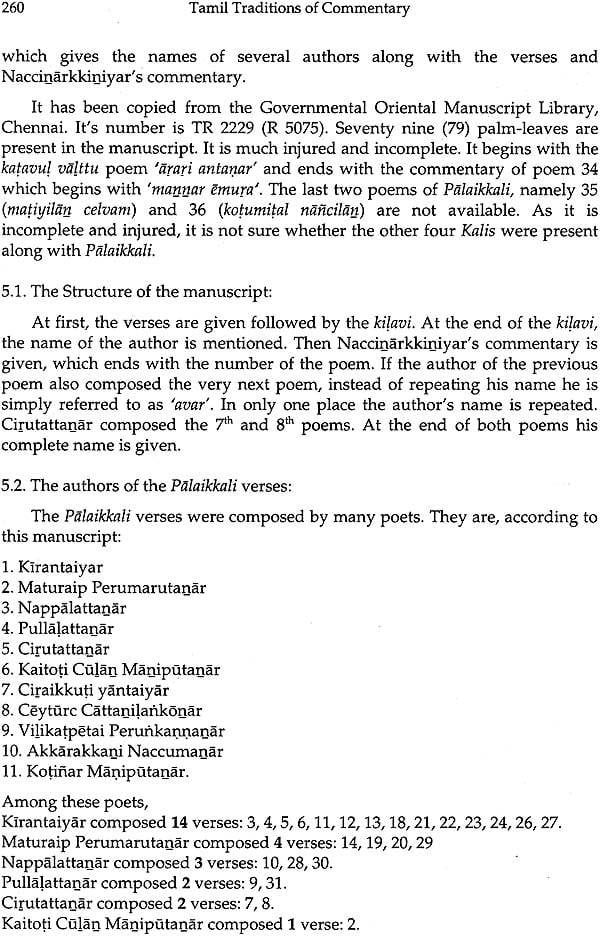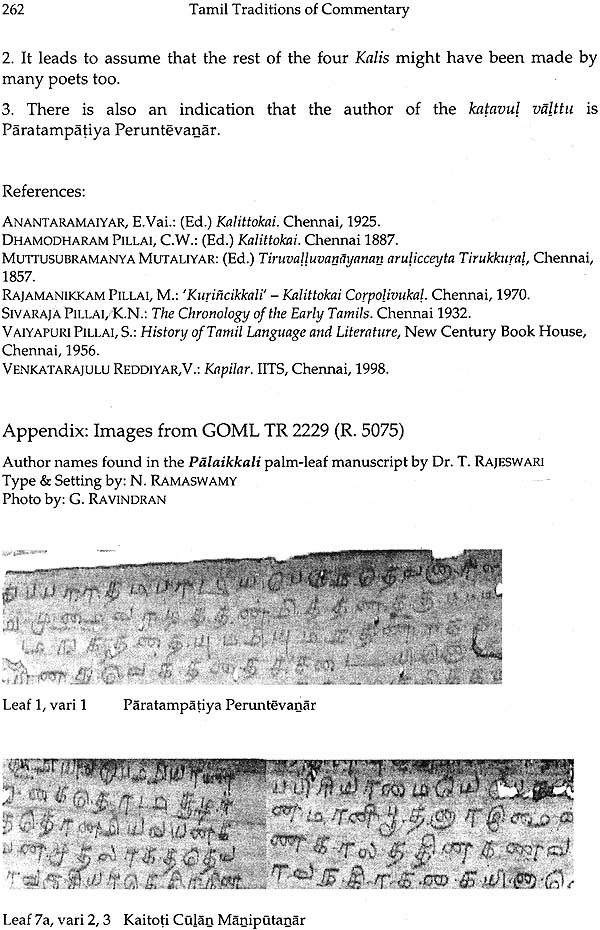
Between Preservation and Recreation: Tamil Traditions of Commentary (Proceeding of a Workshop in Honour of T.V. Gopal Iyer)
Book Specification
| Item Code: | NAM633 |
| Author: | Eva Wilden |
| Publisher: | Institute Francais de Pondichery |
| Language: | English |
| Edition: | 2009 |
| ISBN: | 9788184701739 |
| Pages: | 324 |
| Cover: | Paperback |
| Other Details | 9.5 inch x 7.0 inch |
| Weight | 570 gm |
Book Description
The seed from which this book germinated was a workshop entitled "Between Preservation and Recreation: Tamil Traditions of Commentary in Pursuit of the Cankam Era", held in the Pondicherry Centre of the EFED from the 26th to 28th July 2006 in honour of the late and much lamented Pandit T.V. Gopal Iyer. The volume had been conceived as a felicitation volume of a particular kind, not simply a collective gift of essays loosely connected with his domain of study, but a concerted effort at improving our understanding of an area in which he had been a guide and landmark for almost all of us who met on that occasion: Tamil commentarial literature. A presentation of the life and work of T.V. Gopal Iyer, along with a voluminous bibliography, is followed by essays on different commentarial genres.
After a general introduction into the topic by Eva Wilden (EFEO Paris/Hamburg), Thomas Lehmann (SA] Heidelberg/EFEO Pondicherry) gives a survey of the types of commentary found in Tamil. jean-Luc Chevillard (CNRS) addresses problems related to the interaction between Sanskrit and Tamil by following the transfer of a subset of scholastic terminology from one language to the other. G. Vijayavenugopal (EFEO Pondicherry), Eva Wilden and A. Dhamodharan (formerly SAI Heidelberg) deal with the genre of grammatical and poetological commentaries and their conception. Martine Gestin (Laboratoire d'Anthropologie Sociale, EHESS/College de france) explores the possibilities of retrieving social and anthropological information from a poetological commentary. T.V. Gopal Iyer (t2007), his brother T.S. Gangadharan and T. Rajeswari (all 3 of the EFEO Pondicherry) deal with different aspects of the tradition of literary commentaries. R. varadadesikan (EFEO Pondicherry) introduces the genre of Vaishnava theological exegesis and, finally, Sascha Ebeling (Chicago) characterises the "neo- commentaries'' of the 19th century.
This book is the outcome of a workshop entitled "Between Preservation and Recreation: Tamil Traditions of Commentary in Pursuit of the Cankam Era", held in the Pondicherry centre of the EFEO from the 26th to 28th July 2006. The event was planned as an occasion to honour a man who had attained more than 80 years in the service of Tamil language and literature, and who had been employed by our institution for almost 30 years: Pandit T.V. Gopal Iyer. The volume was meant to be a felicitation volume of a particular kind, not simply a collective gift of essays somehow or other connected with his domain of study, but a concerted effort at improving our understanding of an area in which he had been a guide and landmark for almost all of us who met on that occasion. In July 2006, his vibrant mind and unimpeded zeal still prevailed over the frailties of an aging body. Although he already found it difficult to move about, once he was seated in his chair he was with us as completely as ever he had been. Time, alas, does not stand still. On the first of April 2007 he finally succumbed to the illness that had struck him down during the preceding months. Our felicitation has become a commemoration.
In fact this sad development has not greatly changed the structure of the present volume. A presentation of the life and work of T.V. Gopal Iyer had been planned from the outset, and luckily a lengthy interview was conducted (and recorded)", in August 2006, with the end of making him tell his own story, the story of a pandit of the last generation, a traditional education side by side with 'modem' university degrees. R. Ilakkuvan (Tamilppulavar Kalluri Thanjavur) has taken the pains to transcribe his spoken word into a text, which is at the basis of the Tamil version entitled "tamil palutta ullam", the opening section for the biographical part of this book. It is followed by an English version of T.V.G.'s life story and by a bibliography which may not be complete, but which is quite voluminous nevertheless.
The bulk of the book, then, will be devoted to tracing the outline of a largely un-chartered territory in the area of Tamil studies, that of Tamil commentaries. Anybody who has known T.V.G. will at once perceive the connection between the two parts of this book. A commentary is, put most simply, an explanation of a basic text which is, for one reason or another, hard to understand. T.V.G. has been the breathing and walking embodiment of a commentary for more than one generation of students, Indian and Western, trying hard to understand the intricacies and the implications of Tamil texts, be they poetic or theoretical. He was a living demonstration of the remarkable strengths of an age-old exegetical tradition: his vast memory encompassed not only the Tamil works themselves, from Cankam times onwards right up to the 19th century, but also the explanations and interpretations given by generations of commentators, a highly complex intellectual universe of transmitting, retaining and subtly modifying what had been said and thought. He would know, or would know where to look for the answer to any question that had been and could have been asked within that universe, and he would give it willingly, with a smile on his face, just for the asking, no matter who it was that asked him. Incidentally he also made visible an inherent weakness of that system of knowledge, a scholasticism that amounted at times to inflexibility - a hoast of questions had not been asked and consequently could not be asked within that universe. Far from being a criticism of him and the few scholars of his dwindling generation this last remark was meant to capture some of the tension of intellectual curiosity that kept us together during the days of that workshop. Widely differing in age, background and education we formed a group that had some questions and problems in common and others not.
Now that he has left us we have to get on as best we can, with the consciousness that with him one track of memory has been extinguished, bearing testimony to vast resources of knowledge. We do not honour our teachers by celebrating them while they are alive or by lamenting them when they are no more, but by continuing the work to which they initiated us.
Many people have helped in the production of this volume, first of all, of course, the participants of the original workshop in 2006. My thanks go to all of them. Special thanks go to T.S. Gangadharan (EFEO Pondy) and R. Ilakkuvan (Tamilppulavar Kalluri, Thanjuvur) who made a huge effort to establish the biographical and bibliographical data concerning the life and works to T.V. Gopal Iyer. Thanks go to G. Vijayavenugopal (EFEO Pondy) and T. Rajeswari (EFEO Pondy), Jean- Luc Chevillard (CNRS Paris), Whitney Cox (SOAS London), Sascha Ebeling (University of Chicago) and Vincenzo Vergiani(University of Cambridge) for helping with the proof-reading and formatting, to N.Ramaswamy and G. Ravindran (both EFEO Pondy)for providing the photographs, and finally to Valerie Gillet (EFEO Pondy) for written the French resumes attached at the end of this book.
Between Preservation and Recreation - Tamil Traditions of commentary
1. Preliminaries
Tamil, the second classical language of India, can boast not only of a rich and complex literary tradition reaching back for about two millennia, but also of a complementary tradition of textual exegesis the beginnings of which are shrouded in mist, while officially they are put down to the 8th century, with Nakkiran's famous commentary on the Iraiyanar Akapporul. Now even setting aside the usual hazards of dating,' there is something striking in such an assumption, namely the fact that with Nakkiran we are already faced with a fully developed specimen of commentarial idiom and technique. There is nothing experimental or preliminary about the style of this text, a fact that has traditionally been put down on the one hand to the literary genius of the author. On the other hand it has been explained by the ubiquitous construction of the oral predecessors: Tamil theoretical texts would never have been comprehensible by themselves, but had always presupposed a teacher-disciple relationship that ensured the transmission of the necessary explanations. With these few sentences we have already managed to get into the thick of things.
Yet, however the question of absolute dating might be decided, next in line are two anonymous commentaries on less well-known treatises, the Tamil Neri Vilakkam (Akam poetics) and the Yapparunkalaoirutti (metrics; important because of its numerous references to and quotations from lost texts), followed by Kunacakarar on the Yapparunkalakkarikai (metrics), followed by Ilampuranar on the Tolkappiyam, and then before long we are safely inside so dense a network of cross-references that we can safely speak of a tradition. All of them clearly appear to be linked to a domain termed, in Tamil, ilakkanam, subdivided into eluttu, col and porul, that is, grammar consisting of the three subdiciplines phonetics, morphology, semantics and syntax plus poetics and/or rhetorics. The long and the short of this introduction is that actually we do not know very much, either about the period in which the first commentaries were produced, or about the situation or the motivation of their authors. What we do know can be put into five brief, if somewhat generalising, paragraphs. Our knowledge is far more detailed, or perhaps one had better say, the sources for possible knowledge are much more extensive and varied in the case of the second great phase of commentary production, i.e. the modern one starting in the 19th century, which will be treated separately. This introduction will close with a brief survey of the papers assembled in this volume.
2. Historical Setting
The picture of the situation in Southern India towards the end of the first millennium of the Common Era is said to be uncommonly detailed." This may be true in a number" of respects, such as politics and economy, but from the perspective of literary activity the picture has to be qualified. VELUTHAT (1993: 12), in his introduction, writes: "The literary works of this period can be generally classified, again, in two groups: (a) the one centring on temples, and (b) the one centring on courts. The first category has been subjected to analysis by a number of pandits and historians ( ... ) The court literature has not received the same amount of detailed treatment, although they too have striking parallelisms with the bhakti literature both in form and content. This, however, is a question to be looked into." What is striking about this statement is, in our context, the fact that among the literary activities of the period the theoretical works are not even mentioned. Yes, people produced bhakti literature and court poetry (and some other things), but they also developed a whole new set of exegetical tools for dealing with literature that already existed: further subdivisions of ilakkanam, threefold grammar, such as yappu (metrics) and alankara (stylistics), the genre of nikantus (literary dictionaries) and, incidentally, that of commentaries.
Politically speaking we have three forces contending for power after the end of the ominous Kalabhra interregnum: first the Palla vas, very much oriented towards the North and Sanskrit culture, and there seems to be little relation between them and Tamil literature, unless the fact that the first bilingual inscriptions are Pallava is counted in that respect. The one literary work officially composed at a Pallava court (that of Nandivarman III in the mid-9" c.) is the Nantikkalampakam, first instance of a new poetic genre. Disputed is a second work, the Parataoenpa, according to the Tamil tradition also belonging to the same period and environment.
The second force is the revived dynasty of the Pantiyas, whose relationship with the Cankam kings of the same name is not clear. Ideologically they apparently sought affiliation, for in their inscriptions they claim a share, for their as yet unnamed ancestors, in an activity for the promotion of Tamil which might be connected with the greater part of the anthologisation of the earlier literature." It is highly probable that they continued to be promoters and sponsors for Tamil language and literature, as has been argued by TIEKEN, while at the same time they were interested in Sanskrit literature and culture, since one (early and lost) Tamil version of the Mahabharata is mentioned in one of their inscriptions." They continued to rule their territory from Maturai, the famous capital of the third Cankam and up to this day the legendary Tamil literary city.
The third force, though appearing slightly later on the political scene, are of course the Colas. By the 10th and well into the mid-IS" centuries they are the dominant power, while being time and again heavily contested by the Pantiyas of the "second Empire". Much more research has been done on the Colas than on their adversaries, and so we have a much more detailed (though still quite incomplete) picture of Cola literary activity. It is at the court of Viracolan alias Vira Racentiran (1012-1044 AD.) that the Viracoliyam is written, and if we are allowed to draw conclusions from this fact as to their language policy, it seems that they promoted Tamil, but in a highly Sanskritised variety." It is of course very tempting to simplify and see the three dynasties at least as factors in the dynamics of the literary traditions: Palla vas for pure Sanskrit, Pantiyas for pure Tamil and Colas also for Tamil, though for a Tamil that draws extensively on Sanskrit theory and lexicon. But given the present state of research such a statement seems merely picturesque.
Another factor is certainly religion, although it is even less clear in which way it might have been effective. Partly it must have led to a compartmentalisation into various literary cultures, the members of which took little notice of each other. Well known is the Cola patronage of fervent (and to some extent bilingual) Shaivism as represented by the Periyapuranam. Perhaps the fact that it was precisely the already Tamil- chauvinistic Shaivism that at the same time drew on theological texts written in Sanskrit (such as the Agamas) that made a grammar like the Viracoliyam (written by a Buddhist at that) possible. Broadly speaking there seems to be virtually no relation between the Shaivaite and Vaishnavite bhakti traditions on the one hand and "academic" literary culture on the other." Commentators do very rarely quote devotional literature. Still, one part of the poetological tradition, the IA and its commentary show some kind of Shaiva affiliation, since the legendary authorship of the treatise is put down to Shiva, and the approval of its commentary to Murukan. Things are different with Buddhist and Jain literature: the epics (the Jain Cilappatikaram and Civaka Cintamani and the Buddhist Manimekalai) have become part of the literary corpus drawn upon for examples in the grammatical and poetological tradition, and of some grammarians we are told they were Jain (Tolkappiyar, Pavananti Munivar, the author of the Nannul) or Buddhist (Puttamittiranar, the author of the Viracoliyam).
What entitles us to speak of "a Tamil literary tradition" when referring to the set of people writing treatises on Tamil grammar and literature and writing commentaries on treatises, and later also on literary works, is the fact that despite the existence of numerous "schools" all of them basically refer to the same corpus of Tamil literature and to each other." The literary corpus concerned is roughly made up of three types of texts, Cankam, Kilkkanakku and epic texts, or, to put it brief, of the literary production of the first millennium minus the bhakti poetry." This means there is a certain conservative or even antiquarian element detectable in the activity of the commentators, which in part might seem inherent in the very genre of the commentary itself: writing a commentary one is concerned with preserving or clarifying a sense (and this is also true for the auto-commentary, a genre likewise not unknown within the tradition).
Put differently, the arising of the commentary as a genre, followed by a phase of intensive commentary writing, betrays a renewal of interest in the past, and probably a reconstruction of that past and a cultural identity in relation to it. This preoccupation with a Tamil past on the part of the commentators explains why in part their agenda is surprising to a modern reader: often the commentator seems less concerned with the wording of the text he is commenting on than with the construction of a set of social norms for a universe in which a given poetic statement (or rule, in the case of a theoretical text) would make sense. And often we perceive a double trespass on his part. He does not properly distinguish between the poetic universe and the real world, and he does not distinguish between the real world of olden days and of his own time. This is the sort of ghostly reality we still find depicted in many historiographic accounts of past events and society.
3. The Value of Commentarial Evidence
The modem reader's dependence on the testimony of the commentaries is enormous, almost absolute. For one thing the editors and commentators of the late 19th century gained access to the texts they were confronted with and had to make sense of via the bridge of the extant commentarial material. (What else could they have done?) Secondly, the commentaries they wrote, and that is the majority of the commentaries we still read today (as will be argued below), are crafted along the lines of the traditional commentaries known to them. Thirdly, almost our whole set of philological tools, grammars, dictionaries, indexes, are heavily indebted to the same reservoir of knowledge. No doubt at all we have much reason to be grateful not to have been plunged all on our own into the fairly hermetic universe of classical Tamil literature. But, in order to evaluate the evidence available in detail it is unavoidable to understand the interests and the techniques of the commentators. This means acknowledging a number of facts:
1. There is a time gap between the early classical texts and the medieval commentaries that is about as wide as the one separating us from those commentators, namely roughly speaking between 500 and 1000 years.
2. The language of the commentaries is often quite as hard (and sometimes harder) to understand as that of the classical Tamil texts.
3. The commentators were partly already confronted with difficulties similar to our own. This is clearly shown by the innumerable cases where there are several suggestions, either within the same commentary or in the form of debates going on over various commentaries.
4. Those difficulties were only in part openly acknowledged Commentators have developed a technique of simply glossing over awkward passages.
5. One pervasive interest of the commentators (probably less for those on grammar, but very much so for those on poetry and poetics) is morals. This accounts for quite a number of astonishing interpretative decisions on their part at the level of individual textual detail, and it explains at least some of the oscillation between the poetic world and the real one: uneasiness arises when poetic behaviour or norms deviate from worldly norms.
It is the last point that seems to be most in need of further illustration, and so I want to bring in two examples, one mainly of socio-historical interest for the epoch of the commentaries themselves, while the other is of crucial importance for our understanding of the Tamil poetic universe.
At the beginning of the TP Kalaviyal there is a definition of kamakkuttam, "coupling out of passion", one of the basic elements of the secret phase in a poetic love relationship. Rather surprisingly it is explained as one "among the eight [kinds of] marriage [to be found] with those familiar with the Vedas, of the nature [of the marriage] of those connected with the good lyre abiding by the ghat", i.e. the Gandharva marriage. Incidentally this sutra is a fine example of the Sanskrit policy followed in one phase of the Tolkappiyam redaction: loan words are relentlessly translated into Tamil, even if this impedes understanding. In the parallel sutra IA 1 we find a simply kantaruvam for turaiyamai nalyal tunaimaiyor. Now, Naccinarkkiniyar's commentary on this sutra runs over almost four pages (in the edition of T.V. GOPAL IYER). After quoting an apocryphal eight-liner that defines kalavu - thus silently restoring the order of things against the actual TP text, for a definition of kalavu is precisely what we would expect at the beginning of the kalavu section - he, however, does not proceed to explain why the comprehension of a poetological concept should be enhanced by its being embedded in a set of social norms. Instead he establishes the full dharma context by citing sutra-s defining all the eight forms of marriage as known to Hindu law from the Grhyasutras onwards. We will come back to this case in the section on Tamil and Sanskrit.
| Preface | ||
| Remembering T.V. Gopal Iyer | ix | |
| The Death of a Discipline: In memorian T.V.Gopal Iyer | xi | |
| Biography of T.V.G | ||
| Tamil palutta ullam (in Tamil) | 1 | |
| A Life-time for the Cause of Tamil | 13 | |
| Bibliography of T.V.Gopal Iyer | 23 | |
| C. V of T.V. Gopal Iyer | 35 | |
| Introduction | ||
| Between Preservation and Recreation- Tamil Traditions of commentary | 37 | |
| General Outlines | ||
| A Survey of Classical Tamil Commentary Literature | 55 | |
| The Meta- grammatical Vocabulary inside the Lists of 32 tantrayuktis and Its Adaptation to Tamil- Towards a Sanskrit- Tamil Dictionary | 71 | |
| On Grammar and Poetics | ||
| A Treatise on the Semiotics of Ancient Tamil Poetry | 133 | |
| Canonisation of Classical Tamil Texts in the Mirror of the Poetological Commentaries | 145 | |
| Kalaviyal uraiyin natai (in Tamil) | 167 | |
| A Brilliant Gloss for Tamil Social History: Pre- marital Courtship and Marriage at the Time of Nakkirar | 183 | |
| On Poetry | ||
| Our Debt of Gratitude to the Commentators | 227 | |
| The Commentator's Interpretation Illumines Our Illusive Attempt to Give a Verbatim Meaning- Parimelalakar's Commentary on the Kural | 237 | |
| Palaikkali Verses and Their Authors | 255 | |
| On Theology | ||
| The Influence of Society, Religion and Politics on the Vaisnava Manippiravalam Commentaries Between the 11Th and 15th c. A.D. | 269 | |
| On the Revival of the 19th Century | ||
| Tamil or 'Incomprehensible Scribble'? The Tamil Philological Commentary (urai) in the 19th Century | 281 | |
| Notes on the Authors | 313 | |
| French Resumes | 317 |
